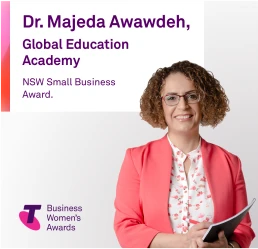
From 2023 NAPLAN reports are changing to using 4 proficiency levels instead of the usual bands.
In this blog we will discuss:
NAPLAN stands for the National Assessment Program – Literacy and Numeracy. It’s an annual assessment for students in Years 3, 5, 7 and 9. For students in these year groups, the tests typically take up to one week of the school year. Before 2008 it used to be called BASIC Skills Test. Some of the parents who have older kids might remember this name.
Every school is required to administer NAPLAN but parents who do not wish for their students to sit the test can choose to opt out. Given the benefits and the insights it offers, almost all Australian school students sit the NAPLAN tests.
NAPLAN is a national population test and provides a nationwide benchmark to assess whether students are developing the appropriate foundational literacy and numeracy skills needed to be productive members of the community.
Students sit the standardised NAPLAN tests each year in March (used to be in May until 2022).
NAPLAN is aligned to the Australian Curriculum for English and Mathematics and covers four major areas:
Reading
Students read a range of informative, imaginative and persuasive texts and then answer related questions.
Writing
Students are provided with a ‘writing stimulus’ (sometimes called a ‘prompt’ – an idea or topic) and asked to write a response in a particular genre (narrative or persuasive writing).
Language Conventions
This test assesses spelling, grammar and punctuation.
Numeracy
This test assesses number and algebra, measurement and geometry, and statistics and probability.
Questions include both multiple choice and open-ended questions requiring short or long form responses. The duration of the tests varies depending on the year group.
Each student’s raw score on a test is scaled to allow for comparison against other students, resulting in overall NAPLAN scores.
Beginning this year (2023), parents and carers will receive information about their child’s NAPLAN performance that is based on new, more accurate national standards.
The new NAPLAN reports will use proficiency standards with four levels rather than the 10-band structure.
NAPLAN individual student reports from 2008 to 2022 used diagrams on pages 2 and 3 to show the relevant part of the measurement scale in bands for that year level:
Along with the national average score and the national minimum standard for each year level, the diagrams also displayed the range for the middle 60% of students.
On the report’s final page, a brief summary of what students typically demonstrated in the tests for each band was given.
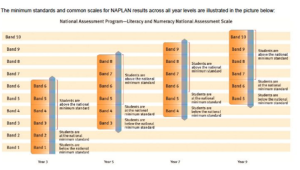
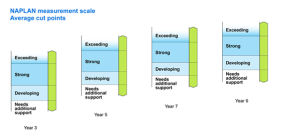
The numerical NAPLAN bands and the national minimum standard will be replaced by the following four levels of achievement:
A few years ago, they were used in school reports. I remember a parent telling me “My daughter’s report always says she is working towards. But it does not tell me towards what.”
It seems that the use of proficiency levels in school reports has resurfaced. However, it appears that some parents still find them vague and unclear in terms of indicating specific areas for improvement. Perhaps there is a need for clearer communication between educators and parents regarding the expectations and goals associated with these proficiency levels.
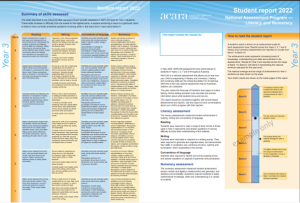
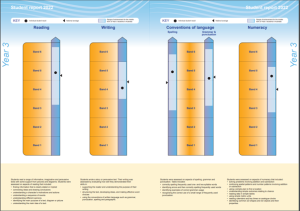
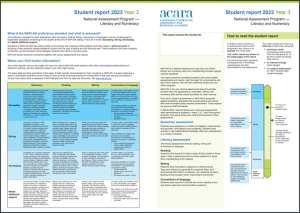
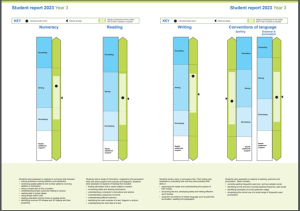
The new report will still display the national average for each test. We don’t see that the school average is shown in the example by ACARA. But I am confident it will be.
Here is an example of what the proficiency levels translate for Year 3:
The student can:
The student can:
The student can:
The student can:
The above is written with a positive tone, informing parents of what their child is capable of.
But how can I as a parent tell what my child needs help with? especially if it’s my first child, if I’m a parent who’s new to Australia and doesn’t know what subjects need to be covered, or even if I’m a parent who can’t figure out how the curriculum loops together? Again, it is leaving parents in the dark.
Results from 2023 on will not be directly compared with results from 2008 to 2022, according to the ACARA media release and parent guide. Therefore, parents won’t be able to compare the results of 2023 with those of earlier years. which leads us to the big question:
By bringing the NAPLAN testing earlier in the year, it allows for more timely intervention and targeted support for students who may be struggling. This can lead to improved academic outcomes and overall student growth. However, without the ability to compare their performance to previous years, it becomes challenging for parents to gauge their child’s progress over time and identify areas of improvement. Therefore, striking a balance between releasing results earlier and maintaining access to historical data would be beneficial for all stakeholders involved.
What about the levels of proficiency? I’m not sure if that will be of much use. According to ACARA, it is easier to understand and use for parents. That is what they previously said about the bands.
Let me share a little secret with you – the national average can be deceiving! It may lead us to believe that if our child is performing above this average, they are excelling academically. However, the truth is that the national average is not as high as one might think.
As parents, we all want what’s best for our children. We aspire for them to reach their full potential and thrive in their educational journey. That’s why it’s essential to set our sights beyond just meeting expectations.
Rather than settling for mediocrity, we need to aim higher. Our goal should be for our children to achieve proficiency levels that go above and beyond what is considered “average.” We should strive for them to be at the Exceeding proficiency level or at least at the Strong proficiency level.
To help your child unlock their true potential, we offer a range of resources and support tailored specifically to their needs. From personalised tutoring sessions to engaging workshops, we’re here to ensure they excel in every subject and surpass even their own expectations.
Remember, it’s not about comparing your child against an arbitrary average; it’s about nurturing their individual talents and helping them flourish beyond conventional measures of success.
If you discover that your child is performing at the lowest two proficiency levels (rather than just the lowest level), this is cause for concern and requires action.
An intervention plan is crucial at this stage. Whether it involves implementing a tailored learning plan at home or seeking professional help from a reputable tutoring centre, acting sooner rather than later is key. Remember, prevention is always better than cure!
By strengthening your child’s core skills – including Maths, English, and Writing – from an early age, you’ll give them the solid foundation they need to succeed academically and beyond.
Don’t wait! Take charge of your child’s future today and set them up for lifelong success. We’re here to support you every step of the way.




